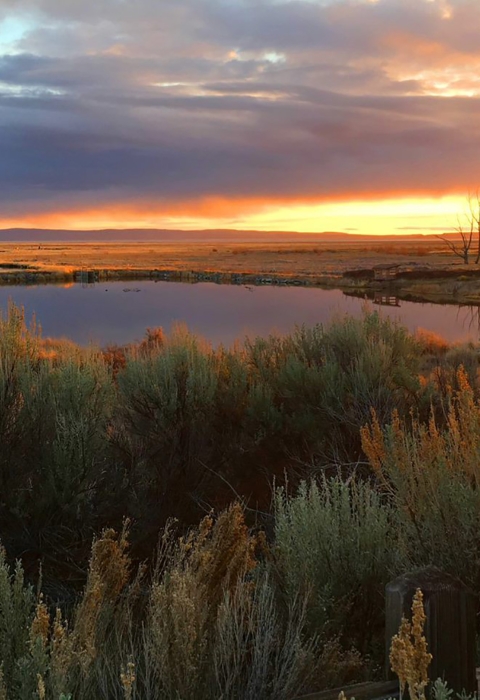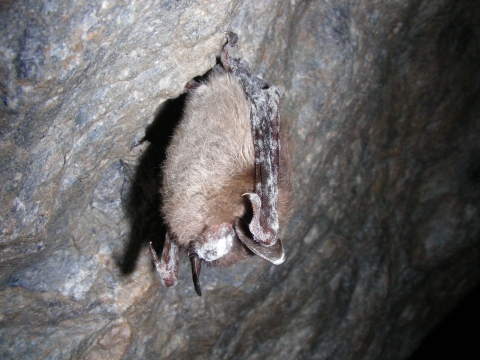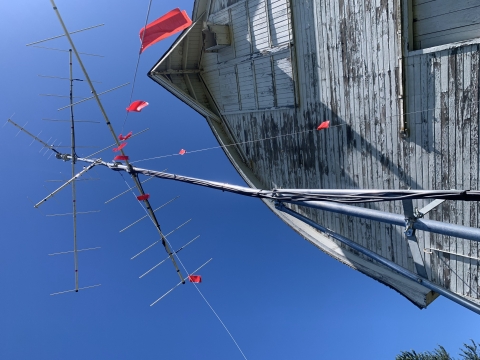How do you fight a fast-moving disease when you can’t even find its victims? U.S. Fish and Wildlife Service biologists know the answer: You can’t. That’s why, as white-nose syndrome marches across the country, they’re stepping up the search for bats on Service-managed lands in the Pacific Northwest.
A disease on the move
White-nose syndrome is one of the most destructive wildlife diseases ever found in North America and one of the gravest threats to our hibernating bat species. It was first detected in New York in 2007 and has spread steadily outward, hopscotching a state here and there. The disease has been confirmed in bats in 40 U.S. states and eight Canadian provinces.
The non-native fungus that causes white-nose syndrome attacks the bare skin of hibernating bats, often producing a powdery covering. Among other symptoms, it can cause them to become active when they shouldn’t be, depleting fat reserves prior to spring and leading to starvation.
White-nose syndrome was found in Washington in 2016. Since then, the disease-causing fungus — but no sick bats — has been found in Idaho. Oregon has yet to confirm the fungus or the disease in the state.
Many places to hide
It’s never easy to find animals at night, but it’s especially hard in the Pacific Northwest. The landscape varies widely due to the mountains and changing weather that sweeps in from the sea, creating habitats — from forests to grasslands — with varying temperatures that bats take advantage of seasonally.
And there are so many places to roost — in buildings, the cracks of tree bark, the region’s distinct dormant lava tubes, and the crevices of bluffs and cliffs, as well as under bridges — from the mountains to the river valleys and coasts.
After years of working on the other side of the Rockies, Partners for Fish and Wildlife program biologist Tyler Porter recognizes the challenges of this region. “Coming from east of the mountains where we know their life history, things are different in the West,” he said. “A lot of habitat here is so rugged, we could put a transmitter on them and not find them the next day.”
“We don’t have a good understanding of white-nose susceptibility in western bat species, given the troubles of surveying them,” said Erin Adams, white-nose syndrome coordinator for our Pacific Region.
Sometimes we get lucky. In northern Idaho, staff at Kootenai National Wildlife Refuge have long monitored a large maternity colony of little brown bats and Yuma bats that use roosting boxes on the shop building. On one night each summer, staff count the bats as they leave the boxes, from sunset until most have emerged or it is too dark to see. With the arrival in Idaho of the fungus that causes white-nose syndrome, this baseline data is important for assessing the impact of the disease on bat populations.
Tuning in to bats
In the human world, the key to understanding another is active listening, and it’s no different with bats. Though imperceptible to the human ear, bats’ echolocation signals can give away their presence and identify their species.
At Malheur National Wildlife Refuge in Oregon, staff have identified 12 of 15 native bat species, using stationary acoustic detectors that record their calls. They’ve confirmed the presence of canyon bats in the basalt rimrock cliffs along the western boundary of the refuge, pallid bats in wetland and sagebrush sagebrush
The western United States’ sagebrush country encompasses over 175 million acres of public and private lands. The sagebrush landscape provides many benefits to our rural economies and communities, and it serves as crucial habitat for a diversity of wildlife, including the iconic greater sage-grouse and over 350 other species.
Learn more about sagebrush steppe habitat, and little and big brown bats that wedge themselves into the bark of trees such as large cottonwoods. Both species of brown bats, along with pallid bats, also roost in historical buildings at refuge headquarters.
Researchers can also locate these elusive skybound species through Motus — a network of tall towers with automated receiving stations that picks up signals from radio transmitters attached to birds and bats. In fall 2022, Ryan Munes, wildlife biologist at Billy Frank Jr. Nisqually National Wildlife Refuge in Washington, had an unusual reading from one of the refuge’s Motus towers.
Usually, the system logs migrating birds, but it detected a hoary bat that made a remarkably speedy 20-day journey from more than 600 miles away in California, where it had been tagged. Bat migration patterns in the Pacific Northwest are relatively unknown, and a northward fall migration was unexpected and notable. The verified record highlights just how much there is to learn.
Southeast Idaho Refuge Complex biologists Andrea Kristof and Deo Lachman — with help from Idaho Fish and Game biologists and refuge volunteers — are launching a multiyear study to learn how these refuges support bats. The project is funded by a Service grant for species being considered for protection under the Endangered Species Act.
Researchers drive preplanned routes, using acoustic detectors to record bats’ echolocation calls and logging GPS coordinates as they go. So far, they’ve recorded maternity colonies in buildings, bats roosting under bridges, and bats foraging over wetlands.
Back in the office, they’ll identify bat species on the recordings and map where each was found. They expect to find hoary and little brown bats, along with silver-haired bats, long-distance, high-flying migrants that might be affected by wind turbines. This new, systematic approach will help them understand the impact on bats of the long-term trend of riparian riparian
Definition of riparian habitat or riparian areas.
Learn more about riparian forest and wetland degradation in the region.
Team effort
We rely on many partners in the search for bats. Because there are no federally threatened or endangered bat species in the Pacific Northwest, state wildlife agencies take the lead on monitoring populations. We share our data with them, as well as with the U.S. Geological Survey’s NABat database. Academic research groups like Oregon State University’s Northwest Bat Hub have helped collect and analyze bat call data. And Friends of Malheur paid for the acoustic detectors on the refuge.
Locating bats in the Pacific Northwest can be as hard as finding a proverbial needle in a haystack. But we're determined because finding the bats is crucial to saving them from white-nose syndrome.







